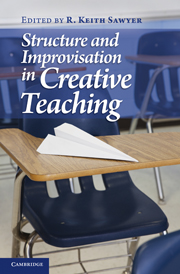Book contents
- Frontmatter
- Contents
- Table and Figures
- Notes on Contributors
- Foreword
- 1 What Makes Good Teachers Great?
- Part 1 The Teacher Paradox
- Part 2 The Learning Paradox
- 6 Taking Advantage of Structure to Improvise in Instruction
- 7 Breaking through the Communicative Cocoon
- 8 Improvising with Adult English Language Learners
- 9 Productive Improvisation and Collective Creativity
- Part 3 The Curriculum Paradox
- Index
- References
6 - Taking Advantage of Structure to Improvise in Instruction
Examples from Elementary School Classrooms
Published online by Cambridge University Press: 05 June 2012
- Frontmatter
- Contents
- Table and Figures
- Notes on Contributors
- Foreword
- 1 What Makes Good Teachers Great?
- Part 1 The Teacher Paradox
- Part 2 The Learning Paradox
- 6 Taking Advantage of Structure to Improvise in Instruction
- 7 Breaking through the Communicative Cocoon
- 8 Improvising with Adult English Language Learners
- 9 Productive Improvisation and Collective Creativity
- Part 3 The Curriculum Paradox
- Index
- References
Summary
Quite early in my career I published a chapter titled “Classroom discourse as improvisation” (Erickson 1982). In it I observed that improvisation is less “free” than popular imagination would have it. Improvisation depends on structure – it works within it, taking advantage of aspects of pattern in order to create new patterns in real-time performance. For example, the improvised performance of a jazz ensemble is based in three levels of structure, each embedded within the next. First, there is the overall form of the song, the chorus structure of sixteen or thirty-two measures, typically in an AABA or ABAC organization of a succession of phrases – constituent units within the overall chorus. Second, within each phrase there is a sequence of chords that, taken together, form a harmonic progression that is sometimes called “changes.” In addition, at the level of time duration of adjacent chords within a phrase sequence, each musician has a repertoire of licks, formulaic melodic contours that he has developed through years of practice, which can be inserted into improvised solos at appropriate moments. The improvisations that emerge are guided by these three levels of structure.
Research shows that expert teachers also are guided by similarly embedded levels of structure. Regarding the first two types of structure — the overall form that guides the song or the classroom and the constituent sequences of “moves” — predetermined chord sequences or oral discourse sequences — Borko and Livingston (1989) found differences in how expert and novice teachers plan in advance.
Information
- Type
- Chapter
- Information
- Structure and Improvisation in Creative Teaching , pp. 113 - 132Publisher: Cambridge University PressPrint publication year: 2011
References
Accessibility standard: Unknown
Why this information is here
This section outlines the accessibility features of this content - including support for screen readers, full keyboard navigation and high-contrast display options. This may not be relevant for you.Accessibility Information
- 9
- Cited by
